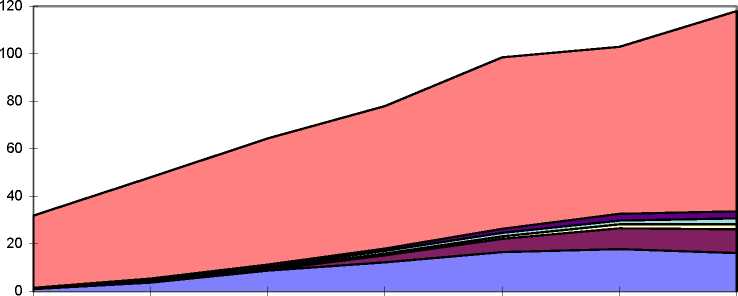The empirical part of the paper makes use of two data sets: One was provided by the division of
‘International Balance of Payments’ at the Austrian National Bank. This data presents the results of a
survey that is conducted annually by roughly 4000 Austrian enterprises that hold at least ATS 1 million
of nominal capital.
A second data set, which is analysed in this paper, presents results of a questionnaire that was conducted
by 1700 Austrian enterprises in the summer of 1997. The enterprises were asked about their specific
motives of investment and their regional sales structure. Hence these data can verify the postulated
objectives of investment.
3. Regional and sectoral patterns of Austria’s FDI in the CEECs
The share of outward FDI-stock by GDP can measure the degree of countries’ transnationalisation. This
indicator shows that Austria's ratio is far below the average of other small OECD countries (UNCTAD,
1996, 261f.).5 However, Austria's outward FDI has improved rather quickly during the period of the
opening of the Central and Eastern European economies (see Fig.1).
Fig.1: Austria’s Outward FDI by destinations, 1989-95
(total capital, in ATS billion)

□ Others
□ Other CEECs
□ Slovenia
□ Slovakia
□ Czech Republic
□ Hungary
1989 1990 1991
1992 1993
1994 1995
For Austria this period of 'globalisation' was characterised by two new and substantial economic
developments: the pre-EU-accession period6 and the opening of Eastern European economies. Both of
them have enforced Austria's international economic activities considerably. However, the FDI-stock-
GDP ratio in 1995 was still relatively low. One of the main reasons for this low degree of
internationalisation is Austria's industry structure, especially the prevalence of SMEs. Most of this
specific Austrian economic feature can be explained only by history (see BELLAK, 1997).
In Fig.1 we can see that Austria’s FDI in OECD countries7 has increased from ATS 30.5 billion (95.6%
of total FDI) in 1989 to ATS 84.3 billion (71.4% of total FDI) in 1995. As mentioned above this was
mainly the result of Austria’s accession to the EU and will not be further discussed in this paper.
More intriguing information
1. Knowledge and Learning in Complex Urban Renewal Projects; Towards a Process Design2. Feature type effects in semantic memory: An event related potentials study
3. A Note on Productivity Change in European Co-operative Banks: The Luenberger Indicator Approach
4. Housing Market in Malaga: An Application of the Hedonic Methodology
5. ANTI-COMPETITIVE FINANCIAL CONTRACTING: THE DESIGN OF FINANCIAL CLAIMS.
6. Towards a Mirror System for the Development of Socially-Mediated Skills
7. The name is absent
8. Cultural Diversity and Human Rights: a propos of a minority educational reform
9. The name is absent
10. Sector Switching: An Unexplored Dimension of Firm Dynamics in Developing Countries